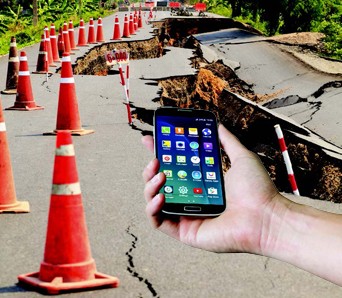Smartphones May Soon Serve as Early Earthquake Warning

By Julianne Glaser
Smartphones have revolutionized the way we work, play, communicate and carry out our day to day lives. Recently, researchers discovered a surprising and potentially life-saving application for this technology: early earthquake detection. This unconventional pocket detector could provide precious seconds for people to take shelter or for utilities to implement emergency shutdown procedures.
Harnessing the Power of Numbers
Most of the world’s population live in areas susceptible to earthquake damage. While automated earthquake early warning (EEW) systems to transmit warnings of tremors are available, high costs limit their use to a few areas such as Japan and Mexico. In the United States, the U.S. Geological Survey (USGS) has been working on development of ShakeAlert as an EEW on the West coast.
Scientists at the USGS are also researching the potential of crowdsourced observations from smartphones to detect, analyze and customize earthquake warnings.
“Crowdsourced alerting means that the community will benefit by data generated from the community,” stated Sarah Minson, USGS geophysicist and lead author of the study. The GPS sensors in smartphones, though less accurate than scientific equipment, are able to detect ground movement caused by fault motion in a large earthquake.
USGS researchers tested crowdsourced smartphone capability using a computer-simulated magnitude-7 earthquake on the Hayward fault in California. In the simulation, a quake was detected if five or more phones registered simultaneous movements of at least five centimeters, but issued alerts only when 100 phones recorded an event to prevent false alarms. The smartphone GPS system detected the simulated earthquake within five seconds, before the strongest tremors occurred in the epicenter and ten seconds before tremors hit nearby regions.
For a real-life comparison, USGS scientists used actual data from the devastating 2011 Tohoku-oki magnitude-9 earthquake in Japan. The team utilized 462 GPS stations across Japan to approximate data from smartphones and aligned detection to reduce false alarm to one in two million.
Researchers found the system would have provided a ten second warning before the earthquake hit Tokyo and several minutes before the subsequent tsunami.
Smartphones could be a cost-effective, life-saving option for areas without detection systems.
Crowdsourced Quake Detection Holds Promise
Jesse Lawrence, a computational earthquake seismologist of Stanford University, acknowledges there are limitations to the smartphone system such as GPS battery drain. Nonetheless, he is optimistic about future applications of this technology: “it’s great research, and this is the first step.”
Extension Questions
- In geology, what is a fault? Where are the largest faults in the world?
- How does GPS work?
- What causes earthquakes? What are the early warning signs?
- What is the Richter scale and how does it work?